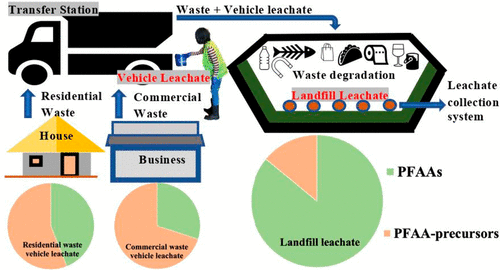当前位置:
X-MOL 学术
›
Environ. Sci. Technol. Lett.
›
论文详情
Our official English website, www.x-mol.net, welcomes your
feedback! (Note: you will need to create a separate account there.)
From Waste Collection Vehicles to Landfills: Indication of Per- and Polyfluoroalkyl Substance (PFAS) Transformation
Environmental Science & Technology Letters ( IF 8.9 ) Pub Date : 2020-10-27 , DOI: 10.1021/acs.estlett.0c00819 Yalan Liu 1 , Nicole M Robey 1 , John A Bowden 2 , Thabet M Tolaymat 3 , Bianca F da Silva 4 , Helena M Solo-Gabriele 5 , Timothy G Townsend 6
Environmental Science & Technology Letters ( IF 8.9 ) Pub Date : 2020-10-27 , DOI: 10.1021/acs.estlett.0c00819 Yalan Liu 1 , Nicole M Robey 1 , John A Bowden 2 , Thabet M Tolaymat 3 , Bianca F da Silva 4 , Helena M Solo-Gabriele 5 , Timothy G Townsend 6
Affiliation

|
Municipal solid waste contain diverse and significant amounts of per- and polyfluoroalkyl substances (PFAS), and these compounds may transform throughout the “landfilling” process from transport through landfill degradation. Fresh vehicle leachates, from commercial and residential waste collection vehicles at a transfer station, were measured for 51 PFAS. Results were compared to PFAS levels obtained from aged landfill leachate at the disposal facility. The landfill leachate was dominated by perfluoroalkyl acids (PFAAs, including perfluoroalkyl carboxylic acids (PFCAs) and perfluoroalkyl sulfonic acids (PFSAs); 86% of the total PFAS, by median mass concentration), while the majority of PFAS present in commercial and residential waste vehicle leachate were PFAA-precursors (70% and 56% of the total PFAS, by median mass concentration, respectively), suggesting precursor transformation to PFAAs during the course of landfill disposal. In addition, several PFAS, which are not routinely monitored—perfluoropropane sulfonic acid (PFPrS), 8-chloro-perfluoro-1-octane sulfonic acid (8Cl-PFOS), chlorinated polyfluoroether sulfonic acids (6:2, 8:2 Cl-PFESAs), sodium dodecafluoro-3H-4,8-dioxanonanoate (NaDONA), and perfluoro-4-ethylcyclohexanesulfonate (PFECHS)—were detected. Potential degradation pathways were proposed based on published studies: transformation of polyfluoroalkyl phosphate diester (diPAPs) and fluorotelomer sulfonic acids (FTS) to form PFCAs via formation of intermediate products such as fluorotelomer carboxylic acids (FTCAs).
中文翻译:

从废物收集车到垃圾填埋场:全氟烷基物质和多氟烷基物质 (PFAS) 转化的迹象
城市固体废物含有多种且大量的全氟烷基物质和多氟烷基物质(PFAS),这些化合物可能在从运输到垃圾填埋场降解的整个“填埋”过程中发生转化。对转运站的商业和住宅垃圾收集车辆的新鲜车辆渗滤液进行了检测,其中含有 51 种 PFAS。将结果与处置设施中陈旧垃圾填埋场渗滤液中获得的 PFAS 水平进行比较。垃圾渗滤液主要成分为全氟烷基酸(PFAA,包括全氟烷基羧酸 (PFCA) 和全氟烷基磺酸 (PFSA);按中值质量浓度计算,占 PFAS 总量的 86%),而大多数 PFAS 存在于商业和住宅垃圾中车辆渗滤液是 PFAA 前体(按中值质量浓度计算,分别占 PFAS 总量的 70% 和 56%),表明前体在垃圾填埋场处置过程中转化为 PFAA。此外,还有几种未常规监测的 PFAS:全氟丙烷磺酸 (PFPrS)、8-氯全氟-1-辛烷磺酸 (8Cl-PFOS)、氯化多氟醚磺酸(6:2、8:2 Cl-)检测到 PFESA)、十二氟-3H-4,8-二氧杂壬酸钠(NaDONA)和全氟-4-乙基环己烷磺酸盐(PFECHS)。根据已发表的研究提出了潜在的降解途径:多氟烷基磷酸二酯(diPAP)和氟调聚物磺酸(FTS)通过形成中间产物(例如氟调聚物羧酸(FTCA))转化为全氟辛酸(PFCA)。
更新日期:2020-10-28
中文翻译:

从废物收集车到垃圾填埋场:全氟烷基物质和多氟烷基物质 (PFAS) 转化的迹象
城市固体废物含有多种且大量的全氟烷基物质和多氟烷基物质(PFAS),这些化合物可能在从运输到垃圾填埋场降解的整个“填埋”过程中发生转化。对转运站的商业和住宅垃圾收集车辆的新鲜车辆渗滤液进行了检测,其中含有 51 种 PFAS。将结果与处置设施中陈旧垃圾填埋场渗滤液中获得的 PFAS 水平进行比较。垃圾渗滤液主要成分为全氟烷基酸(PFAA,包括全氟烷基羧酸 (PFCA) 和全氟烷基磺酸 (PFSA);按中值质量浓度计算,占 PFAS 总量的 86%),而大多数 PFAS 存在于商业和住宅垃圾中车辆渗滤液是 PFAA 前体(按中值质量浓度计算,分别占 PFAS 总量的 70% 和 56%),表明前体在垃圾填埋场处置过程中转化为 PFAA。此外,还有几种未常规监测的 PFAS:全氟丙烷磺酸 (PFPrS)、8-氯全氟-1-辛烷磺酸 (8Cl-PFOS)、氯化多氟醚磺酸(6:2、8:2 Cl-)检测到 PFESA)、十二氟-3H-4,8-二氧杂壬酸钠(NaDONA)和全氟-4-乙基环己烷磺酸盐(PFECHS)。根据已发表的研究提出了潜在的降解途径:多氟烷基磷酸二酯(diPAP)和氟调聚物磺酸(FTS)通过形成中间产物(例如氟调聚物羧酸(FTCA))转化为全氟辛酸(PFCA)。











































 京公网安备 11010802027423号
京公网安备 11010802027423号